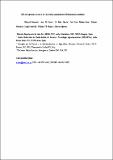Por favor, use este identificador para citar o enlazar a este item:
http://hdl.handle.net/10261/82472COMPARTIR / EXPORTAR:
 SHARE SHARE
 CORE
BASE CORE
BASE
|
|
| Visualizar otros formatos: MARC | Dublin Core | RDF | ORE | MODS | METS | DIDL | DATACITE | |

| Título: | Quantitative trait loci for agronomic traits in an elite barley population for Mediterranean conditions |
Autor: | Mansour, Elsayed CSIC ORCID; Casas Cendoya, Ana María CSIC ORCID ; Gracia Gimeno, María Pilar CSIC ORCID ; Molina-Cano, José Luis; Moralejo, María Ángeles; Cattivelli, Luigi; Thomas, William T. B.; Igartua Arregui, Ernesto CSIC ORCID | Palabras clave: | Barley Breeding QTL Agronomic adaptation Vernalisation VrnH1 |
Fecha de publicación: | 1-feb-2014 | Editor: | Springer Nature | Citación: | Mansour E, Casas AM, Gracia MP, Molina-Cano JL, Moralejo M, Cattivelli L, Thomas WTB, Igartua E. Quantitative trait loci for agronomic traits in an elite barley population for Mediterranean conditions. Molecular Breeding 33 (2): 249-265 (2014) | Resumen: | Advances in plant breeding through marker-assisted selection (MAS) are only possible when genes or quantitative trait loci (QTLs) can contribute to the improvement of elite germplasm. A population of recombinant inbred lines (RILs) was developed for one of the best crosses of the Spanish National Barley Breeding Program, between two six-row winter barley cultivars Orria and Plaisant. The objective of this study was to identify favourable QTLs for agronomic traits in this population, which may help to optimise breeding strategies for these and other elite materials for the Mediterranean region. A genetic linkage map was developed for 217 RILs, using 382 single nucleotide polymorphism markers, selected from the barley oligonucleotide pool assay BOPA1 and two genes. A subset of 112 RILs was evaluated for several agronomic traits over a period of 2 years at three locations, Lleida and Zaragoza (Spain) and Fiorenzuola d’Arda (Italy), for a total of five field trials. An important segregation distortion occurred during population development in the region surrounding the VrnH1 locus. A QTL for grain yield and length of growth cycle was also found at this locus, apparently linked to a differential response of the VrnH1 alleles to temperature. A total of 33 QTLs was detected, most of them for important breeding targets such as plant height and thousand-grain weight. QTL × environment interactions were prevalent for most of the QTLs detected, although most interactions were of a quantitative nature. Therefore, QTLs suitable for MAS for most traits were identified. | Descripción: | 31 Pags., 4 Tabls., 1 Fig. Available online 15 September 2013. The definitive version is available at: http://link.springer.com/journal/11032 | Versión del editor: | http://dx.doi.org/10.1007/s11032-013-9946-5 | URI: | http://hdl.handle.net/10261/82472 | DOI: | 10.1007/s11032-013-9946-5 | ISSN: | 1380-3743 | E-ISSN: | 1572-9788 |
| Aparece en las colecciones: | (EEAD) Artículos |
Ficheros en este ítem:
| Fichero | Descripción | Tamaño | Formato | |
|---|---|---|---|---|
| CasasA_MolBreed_2013.pdf | 266,75 kB | Adobe PDF |  Visualizar/Abrir |
CORE Recommender
SCOPUSTM
Citations
34
checked on 21-abr-2024
WEB OF SCIENCETM
Citations
33
checked on 16-feb-2024
Page view(s)
471
checked on 23-abr-2024
Download(s)
508
checked on 23-abr-2024
Google ScholarTM
Check
Altmetric
Altmetric
NOTA: Los ítems de Digital.CSIC están protegidos por copyright, con todos los derechos reservados, a menos que se indique lo contrario.
